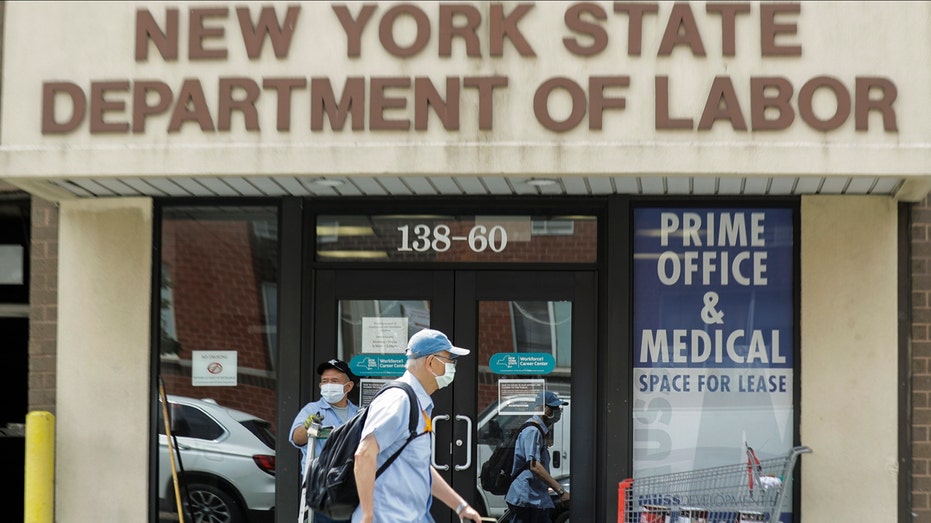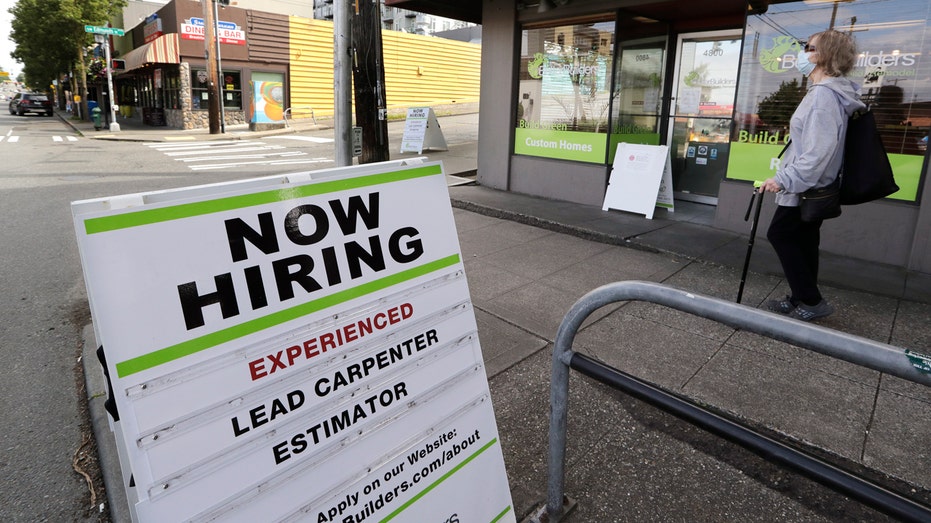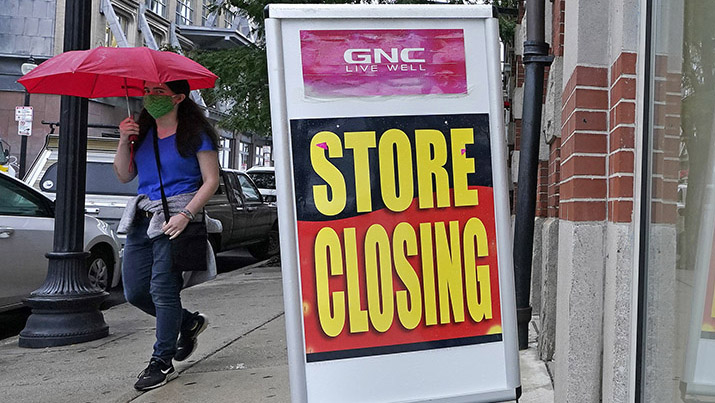US states face biggest cash crisis since the Great Depression
The drop in tax revenue has led to a total shortfall expected in the hundreds of billions of dollars
Connecticut acted fast. Social distancing, lockdowns and testing slashed Covid-19 cases in the spring.
But when Comptroller Kevin Lembo opened an email from his budget director on April 15, it was clear the state’s quick action to contain the pandemic hadn’t insulated its finances.
GET FOX BUSINESS ON THE GO BY CLICKING HERE
“We hit the brakes so quickly on the economy that we went through the windshield,” his deputy wrote.
Connecticut is projecting a total revenue decline of $8.4 billion through the 2024 budget year—more than twice the rainy day fund built up over the past three years.
“All you can do is grip the bar as tight as you can, make the smartest decisions you can in real time, plan for the worst and be surprised at something less than worst,” said Mr. Lembo.

FILE - In this Sept. 2, 2020, file photo, a passerby walks past a business storefront with store closing signs in Boston. The U.S. unemployment rate dropped to 7.9% in September, but hiring is slowing and many Americans have given up looking for work
U.S. states are facing their biggest cash crisis since the Great Depression.
Nationwide, the U.S. state budget shortfall from 2020 through 2022 could amount to about $434 billion, according to data from Moody’s Analytics, the economic analysis arm of Moody’s Corp. The estimates assume no additional fiscal stimulus from Washington, further coronavirus-fueled restrictions on business and travel, and extra costs for Medicaid amid high unemployment.
That’s greater than the 2019 K-12 education budget for every state combined, or more than twice the amount spent that year on state roads and other transportation infrastructure, according to the National Association of State Budget Officers.
WILL A RECORD GDP SURGE BOOST TRUMP'S REELECTION ODDS?
Deficits have already prompted tax hikes and cuts to education, corrections and parks. State workers are being laid off and are taking pay cuts, and the retirement benefits for police, firefighters, teachers and other government workers are under more pressure.
Even after rainy day funds are used, Moody’s Analytics projects 46 states coming up short, with Nevada, Louisiana and Florida having the greatest gaps as a percentage of their 2019 budgets. Louisiana said it didn’t expect its shortfall to be as large as Moody’s projected.
“There is no real model for a crisis like this,” said New Jersey Treasurer Elizabeth Maher Muoio. “It’s going to be tough for the next couple years.”
New Jersey is expecting a more than $5 billion revenue decline for the 2021 budget year, a 13% drop from the state’s pre-Covid projection. Already one of the most indebted states in the nation, New Jersey authorized a contested plan to borrow up to $10 billion; raised taxes on people earning between $1 million and $5 million; and is making another billion in cuts to help plug the gap.

(Photo by Evan Agostini/Invision/AP, File)
States are dependent on taxes for revenue—sales and income taxes make up more than 60% of the revenue states collect for general operating funds, according to the Urban Institute. Both types of taxes have been crushed by historic job losses and the steepest decline in consumer spending in six decades.
TRUMP COULD CUT TAXES BY $1.1T OVER NEXT DECADE IF REELECTED, STUDY SHOWS
Americans have since ramped up spending on everything from home improvements to bicycles with the help of stimulus checks sent to millions, though overall expenditures remain below pre-pandemic levels.
States that earn big chunks of their revenue from hard-hit industries are hurting. Americans are commuting and traveling far less, and oil prices have tumbled, hitting energy industries in Texas, Oklahoma and Alaska. Tourism has dropped in Florida, Nevada and Hawaii, and casino closures hurt Rhode Island, New York and Illinois.
Hawaii, for example, is expecting fewer than half the visitors it took in last year in 2020, and state officials forecast its general fund revenues won’t recover to pre-pandemic levels until its 2025 fiscal year.
For the budget years 2020 through 2022, average annual revenues in all 50 states combined are expected to fall short of the 2019 total, Moody’s Analytics said.

NEW YORK, NEW YORK - AUGUST 25: A person wearing a protective mask walks by a going out of business sign displayed outside a store in Harlem. Photo by Noam Galai/Getty Images)
A nationwide decline in combined state revenue has happened after only two events in 90 years: following the Sept. 11, 2001, attacks and in the aftermath of the 2008 financial crisis.
Annual state revenue fell following the Sept. 11 attacks and the bursting of the dot-com bubble around that time, but recovered within a year. During the recession that followed the 2008 crisis, state government revenue fell 9% over two years, according to Census Bureau data.
FINAL JOBS REPORT BEFORE ELECTION DAY SHOWS US EMPLOYERS ADDED 661,000 WORKERS IN SEPTEMBER
This time the shortfall could reach 13% over two years, according to Moody’s Analytics projections.
An uptick in Covid-19 cases to new daily records in recent days makes that scenario increasingly likely.
The U.S. economy has steadily recovered since the spring, and more than 11 million jobs of the 22 million lost earlier in the year have come back. Still, the unemployment rate recently hovered at 7.9%, and there has been an uptick in permanent layoffs.
Economists warn a two-track recovery is emerging, with well-educated and well-off people and some businesses prospering, at the same time lower-wage workers with fewer credentials, old-line businesses and regions tied to tourism are mired in a deep decline.
State government workforces shrank 5% across the country from February to September to 4.9 million, fewer people than at any point during or after the 2008 recession, according to the Bureau of Labor Statistics. Local government workforces cut 6%, or nearly a million people, and local revenue shortfalls are adding pressure to states’ budgets.
In Michigan, more than 31,000 state workers were furloughed two days per pay period for 10 weeks, while others were temporarily laid off. A spokesman said temporary layoffs have ended and none are currently planned, but that they could be reconsidered if economic fallout worsened.
PANDEMIC USHERS IN NEW PUSH FOR TRADE SKILL JOBS
Earlier this year, Chris Kolb, budget director for the state, calculated that even if he eliminated 12 state departments—including education, environment and treasury—and used up every penny in state reserves, Michigan would still be short $1 billion needed to balance his budget.
Federal coronavirus aid and rainy day funds ultimately helped him balance the budget and cover Covid-related expenses, and some tax revenues were better than initially forecast. But the state is bracing for a shortfall of up to $2 billion for the next fiscal year, since $4 billion in tax revenue that the state anticipated back in January has disappeared.

Pedestrians pass an office location for the New York State Department of Labor (AP Photo/Frank Franklin II) (Associated Press)
“We really have uncharted waters in front of us,” Mr. Kolb said this month. “The waves appear to be getting more choppy.”
After 2008, some states implemented or added to rainy day funds—cash reserves that can be used to fill revenue gaps caused by a potential shock. The funds are important because state laws typically don’t allow states to supplement operating revenues with borrowing, in contrast to the federal government, which helps finance its operations with Treasury bonds. States, on the other hand, typically issue bonds for specific projects, such as building roads or bridges.
At the end of the 2019 budget year, state rainy day funds had accumulated about $50 billion over the previous decade, according to the Pew Charitable Trusts, putting about two-thirds of states in a better position than they were heading into the 2008 crisis.
States had a median of more than four times the number of days of cash on hand as when they emerged from the recession in 2010. Connecticut’s rainy day fund at the end of 2019 ranked 11th out of the 50 states, according to Pew, with about 40 days worth of cash on hand. The stockpile grew to about two months worth of cash in 2020.
Ohio, which like Connecticut had emptied its reserves by 2010, had about a month’s worth of cash when Covid hit.
Since then, Ohio has cut $300 million from its K-12 education budget for the 2020 budget year and reduced salaries for some state workers.
The Willoughby-Eastlake City Schools near Cleveland lost $1.7 million in state funds this year, and expects to lose another $1.7 million in 2021. The school district made ends meet by halving its curriculum budget and buying fewer textbooks and other learning aids, among other cuts.
If the money doesn’t arrive eventually, the district will have to reduce course offerings, said Superintendent Steve Thompson.

Interior of classroom in elementary school. Row of empty desks are in illuminated room.
School systems also usually receive local funds through property taxes. This year, the Willoughby-Eastlake system has so far received $800,000 less than last year, the district’s treasurer said, as out-of-work residents struggle to pay the tax.
Schools received federal aid from the pandemic-stimulus packages passed by Congress earlier this year. Willoughby-Eastlake received $1.3 million that it used for technology, health and cleaning supplies and additional custodians. The money was quickly spent, the superintendent said.
About 30% of the district’s roughly 8,000 students qualify for free or reduced-price lunch, and many lack computers or internet access at home. The district, which has online classes, has purchased hundreds of computers and hot spots. “At this point we’re spending dollars out of our general fund,” said Mr. Thompson, who estimated that total technology and health-safety costs from the start of the pandemic to the end of the current school year will approach $4 million.
Teachers are recording classes so that students in families sharing one computer can watch lessons that they miss because their siblings are using the computer for their own online classes.
“If they have a question, they’re going to have to wait until the next day when it’s their turn to have the Chromebook from their brother or sister,” Mr. Thompson said.
The Ohio Education Association, a teachers union, said the state’s school districts could face budget shortfalls for the 2022 and 2023 budget years of between 20% and 25%.
New York, projecting a shortfall of $59 billion through 2022, held back scheduled payments for schools and social services and postponed public worker raises. Missouri has held back funding for services for the elderly and other programs. Florida’s governor vetoed spending on a range of items including a new state courthouse, trade schools and appropriations for local projects.
A few states are likely to come through the pandemic in comparatively good shape thanks to robust savings, tight financial controls or local economies that are insulated from the worst impacts of social distancing.

Bubble tents are set up outside Cafe Du Soleil following the outbreak of the coronavirus disease (COVID-19) in the Manhattan borough of New York City, REUTERS/Jeenah Moon - RC2K4J9Z967F
Wyoming, though dependent on energy prices, has a very large rainy day fund relative to other states. Minnesota and North Carolina have some of the highest credit ratings in the nation and foster a mix of manufacturing, education, health care and business services, according to Moody’s Investors Service, the rating arm of Moody’s.
Many states are pleading for more aid from Congress, which has so far sent money in its coronavirus relief packages to deal with the health crisis but not to offset revenue losses.
Congress has doled out about $150 billion in Covid-19 response dollars to state and local governments, plus some additional money to cover elevated Medicaid costs. The money sent to local governments has helped pay for needs like personal protective equipment. But it can’t be used to replace revenue lost as a result of the shutdown.
In recent weeks, White House and Democratic negotiators have been discussing roughly $2 trillion in additional stimulus, but the price tag has encountered resistance in the Republican-controlled Senate amid concerns about rising debt and some of the expected provisions, and a deal is unlikely to come together before the election.
In the negotiations, House Speaker Nancy Pelosi and White House officials moved closer on many issues, including how much additional aid to provide to state and local governments, but had not yet reached an agreement finalizing an amount.
President Trump and Senate Majority Leader Mitch McConnell have said they don’t want Covid-19 aid used to address longstanding financial problems. Mr. McConnell suggested in April that states should be allowed to file for bankruptcy to address their pension debt. Mr. Trump asked in a tweet that month: “Why should the people and taxpayers be bailing out poorly run states like Illinois?”
Illinois, with the worst finances of any state, has been banking on billions in federal funding. The state has a $230 billion pension liability after years of putting off payments, according to an estimate by Moody’s Investors Service, and faces an additional $8 billion backlog of unpaid bills.
Since the pandemic, Illinois’s total retirement and debt liabilities are on track to make up 45% of the state’s gross domestic product by June 2021, up from 35% in 2019, according to Moody’s Investors Service.
Illinois was one of only two borrowers to tap loans offered from the Federal Reserve as part of the aid packages. New York’s Metropolitan Transportation Authority was the other.
Illinois issued $1.2 billion in notes, but the funds are expensive, with an interest rate about 10 times the level typical in the market. The state has said it could borrow more. A spokeswoman for the state didn’t respond to requests for comment.
Over the past six months, there have been 51 first-time bond payment defaults, according to Municipal Market Analytics data. It’s the highest level over that time frame since 2012, when a string of borrowers still reeling from the last recession ran out of money to pay their debts.

A pedestrian wearing a mask walks past reader board advertising a job opening for a remodeling company. Photo/Elaine Thompson, File) (Associated Press)
While none of the recent defaults have involved state credits, some local governments are facing repayment strains. The airport authority of Rock Island County, Ill., for example, disclosed in August that it hasn’t been able to collect enough in airline ticket fees to maintain the level of cash it promised bondholders it would set aside. The authority filled in the gap with other funds, such as parking lot revenues, and may consider delaying capital projects, its executive director said.
In Connecticut, debt costs have reduced the state’s spending flexibility. Before the pandemic, yearly payments on bond debt, pensions and retiree health obligations absorbed 31% of state-generated revenue, according to Moody’s Investors Service, making it one of the most indebted states in the nation.
Much of Connecticut’s liability stems from state efforts to shoulder the burden of its aging cities and towns. Almost a third of its total debt is local teacher pension and retiree health-benefit obligations, Moody’s Investors Service said, much of it from the 1990s, when officials skimped on retirement payments.
Two years ago, the state backstopped debt issued by its capital city of Hartford, which was warning it could declare bankruptcy.
The state’s hospitality and leisure jobs were down by about half at the height of the shutdowns, according to the Boston Fed, and were still down by about a quarter in August, despite a partial recovery. The state’s total unemployment rate was 9.5% in August.
The flurry of home buying as people fled New York City for Connecticut towns has had limited revenue benefits. The state’s tax collections from real-estate sales surged to a 10-year high of $47 million in August, according to the state revenue services department, but total collections from April through August remain below where they were the past two years.
To address the shortfall in this year’s budget, Connecticut’s governor is recommending the state make about $25 million in cuts and draw on its rainy day fund. The state has avoided reducing state funding to social-service providers despite revenue losses, said Melissa McCaw, secretary of the state’s Office of Policy and Management.
Groups that provide mental-health and substance-abuse treatment have received federal aid to help with Covid-related health and safety costs, but have asked for additional state help as well. Ms. McCaw said the state “will continue to monitor provider needs.”
Connecticut has historically been one of the top 10 states for drug overdoses, which have increased during the pandemic, spiking higher in the first quarter of 2020 than in any of the previous eight quarters, according to the Centers for Disease Control and Prevention.
Community Health Resources, which offers mental-health and addiction services to 27,000 children and adults, is concerned it won’t receive its expected more than $40 million in state funding—62% of the organization’s annual budget—in the next fiscal year, which begins in July.
CLICK HERE TO READ MORE ON FOX BUSINESS
“We are working with individuals who, were it not for our services, would be in emergency rooms,” said CEO Heather Gates.
Write to Heather Gillers at heather.gillers@wsj.com and Gunjan Banerji at Gunjan.Banerji@wsj.com




















